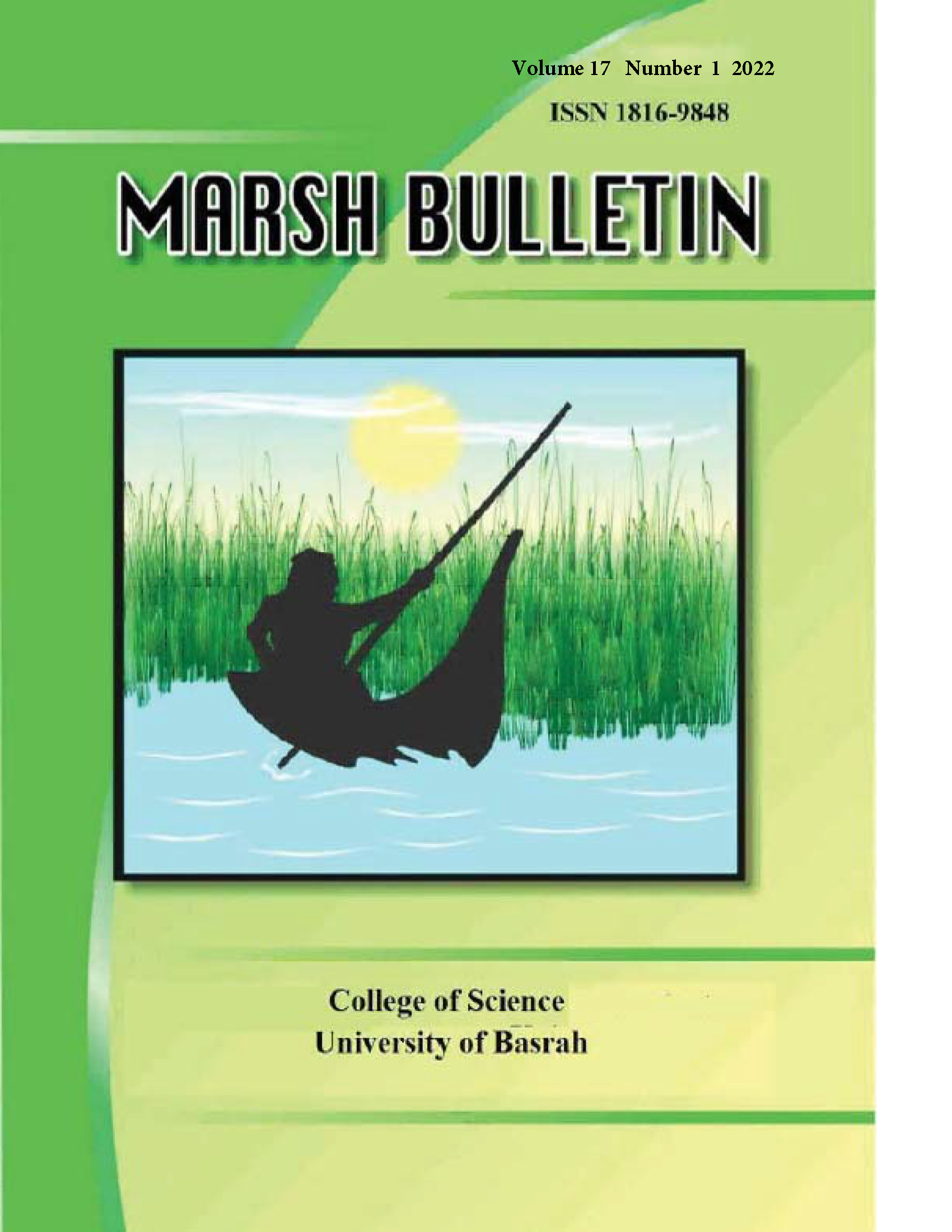Abstract
Shatt Al-Arab River is regarded as one of the most important rivers in Iraq and the main
source of surface water in Basra governorate. Its water is used for various purposes; drinking,
irrigation, fisheries, navigation, and industry. Shatt Al-Arab River forms at Qurna where the
Tigris and Euphrates Rivers join together, it’s a conjunction link of freshwater from Iraq into
the Arabian Gulf.
This river has been subjected to increase salt concentration; the principal reason for this is local
and regional factors. The former is due to water pollution. The latter is the low-level discharge
from Tigris and Euphrates. The high salt level in Shatt al-Arab is a threatening environmental
disaster.
In this paper, factors that participate in the present-day state of Shatt Al-Arab to change the
physical properties of its water have been studied by analyzing the effect of natural and
anthropogenic variations of main sources and by analyzing data observation of salt in Shatt AlArab and water discharge in Kassarah Dam, with focusing on the future challenges expected
for Euphrates and Tigris rivers and their effects on Shatt Al-Arab, mostly based on a literature
review of recent foreign publications on the problem.
The results show a significant increase in salinity over time from upstream to downstream of
Shatt Al-Arab, resulting in a decline in quantity and quality of freshwater, and as long as the
sources of Shatt Al-Arab go on water shortage or dry up; water of Shatt Al-Arab will turn into
seawater coming from the Arabian Gulf with the tidal wave.
source of surface water in Basra governorate. Its water is used for various purposes; drinking,
irrigation, fisheries, navigation, and industry. Shatt Al-Arab River forms at Qurna where the
Tigris and Euphrates Rivers join together, it’s a conjunction link of freshwater from Iraq into
the Arabian Gulf.
This river has been subjected to increase salt concentration; the principal reason for this is local
and regional factors. The former is due to water pollution. The latter is the low-level discharge
from Tigris and Euphrates. The high salt level in Shatt al-Arab is a threatening environmental
disaster.
In this paper, factors that participate in the present-day state of Shatt Al-Arab to change the
physical properties of its water have been studied by analyzing the effect of natural and
anthropogenic variations of main sources and by analyzing data observation of salt in Shatt AlArab and water discharge in Kassarah Dam, with focusing on the future challenges expected
for Euphrates and Tigris rivers and their effects on Shatt Al-Arab, mostly based on a literature
review of recent foreign publications on the problem.
The results show a significant increase in salinity over time from upstream to downstream of
Shatt Al-Arab, resulting in a decline in quantity and quality of freshwater, and as long as the
sources of Shatt Al-Arab go on water shortage or dry up; water of Shatt Al-Arab will turn into
seawater coming from the Arabian Gulf with the tidal wave.
Keywords
ecosystems
freshwater
future challenges
salinization
watersheds
Abstract
يعد شط العرب واحدا من االنهر الرئيسية والمهمة في العراق ، كما يعتبر المصدر الرئيسي للمياه السطحية في محافظة البصرة.
وتستخدم مياهه في مختلف االغراض ، للشرب والري والصناعة والنقل وصيد االسماك.
يتكون نهر شط العرب من التقاء نهري دجلة والفرات في القرنة وينقل المياه العذبة من العراق الى الخليج العربي . يتعرض نهر شط
العرب لتزايد تراكيز الملوحة ، تعزى اسباب هذا التزايد الى اسباب محلية واخرى اقليمية: المحلية ناتجة من زيادة تلوث المياه
واالقليمية ناتجة عن قلة تصريف المياه الواصلة لشط العرب. ان ازدياد تركيز االمالح ينذر بكوارث بيئية.
في هذه الدراسة تم تناول العوامل التي تساهم في تغيير الخصائص الفزيائية للمياه من خالل تحليل بيانات مرصودة لالمالح وتصاريف
المياه عند سد الكسارة كما تم تسل ي ط الضوء على التحديات المستقبلية التي تواجه المصادر الرئيسية لنهري دجلة والفرات وتاثيرها
على شط العرب.
يتضح من النتائج بان تركيز االمالح في تزايد مع الزمن، سيؤدي الى تدهور نوعية وكمية المياه في شط العرب، ولكون مصادر
مياه شط العرب الرئيسية ستتعرض الى نقص حاد في تصريفها او جفافها مستقبال فان مياه شط العرب ستتحول الى مياه بحرية
قادمة من الخليج العربي بتاثير المد والجزر.
وتستخدم مياهه في مختلف االغراض ، للشرب والري والصناعة والنقل وصيد االسماك.
يتكون نهر شط العرب من التقاء نهري دجلة والفرات في القرنة وينقل المياه العذبة من العراق الى الخليج العربي . يتعرض نهر شط
العرب لتزايد تراكيز الملوحة ، تعزى اسباب هذا التزايد الى اسباب محلية واخرى اقليمية: المحلية ناتجة من زيادة تلوث المياه
واالقليمية ناتجة عن قلة تصريف المياه الواصلة لشط العرب. ان ازدياد تركيز االمالح ينذر بكوارث بيئية.
في هذه الدراسة تم تناول العوامل التي تساهم في تغيير الخصائص الفزيائية للمياه من خالل تحليل بيانات مرصودة لالمالح وتصاريف
المياه عند سد الكسارة كما تم تسل ي ط الضوء على التحديات المستقبلية التي تواجه المصادر الرئيسية لنهري دجلة والفرات وتاثيرها
على شط العرب.
يتضح من النتائج بان تركيز االمالح في تزايد مع الزمن، سيؤدي الى تدهور نوعية وكمية المياه في شط العرب، ولكون مصادر
مياه شط العرب الرئيسية ستتعرض الى نقص حاد في تصريفها او جفافها مستقبال فان مياه شط العرب ستتحول الى مياه بحرية
قادمة من الخليج العربي بتاثير المد والجزر.
Keywords
مستجمعات المياه، تحديات مستقبلية/ تملح، مياه عذبة، النظم البيئية
